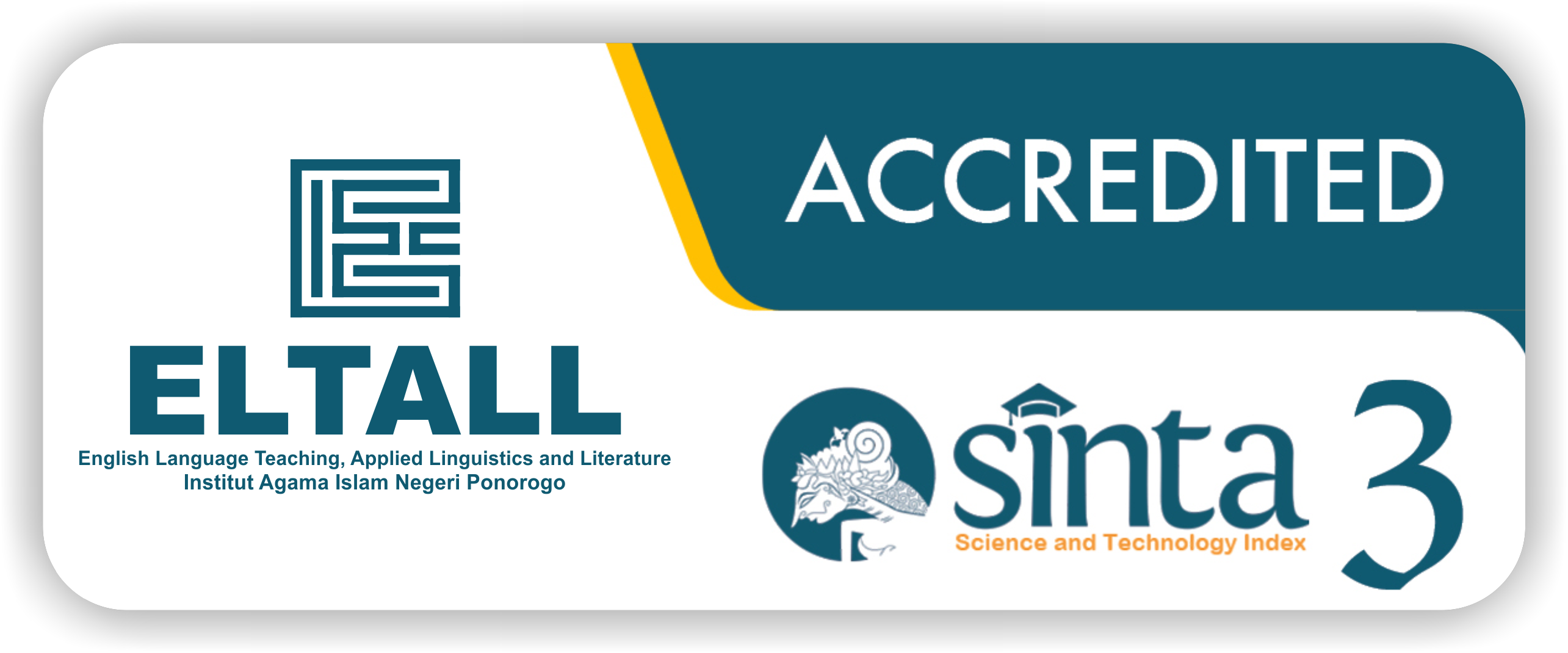The Effectiveness of Using Advertisement to Improve Students’ Writing Skill
DOI:
https://doi.org/10.21154/eltall.v4i01.5007Keywords:
Advertisement, English Teaching, Writing SkillAbstract
This research was conducted to analyze the effectiveness of using advertisements in improving students writing skills. The subject of this research was an English teacher and 26 students in X-MIPA class. To gather the data, the interview and questionnaire were conducted and the interview was done with the teacher the questionnaire was given to the students and then qualitatively analyzed. To analyze the data gotten, these steps were used; data reduction, data display, and conclusion. The study's conclusions showed that using advertisements in writing lessons helped students feel happy, enthusiastic, and motivated. However, some students had trouble expressing their thoughts in writing lessons due to a lack of vocabulary. The usage of advertisements in the classroom has helped students' writing abilities. Based on these findings, it is recommended that all teachers use advertising intensively in their teaching to further improve their students' writing skills.References
As, A., Wardarita, R., & Wardiah, D. (2021). Improving the ability of writing advertising sentences in students. JPGI (Jurnal Penelitian Guru Indonesia), 6(2), 358. https://doi.org/10.29210/021055jpgi0005
Austen-Leigh, J. E. (2010). Chapter I. In A Memoir of Jane Austen (pp. 1”“30). https://doi.org/10.1017/cbo9780511702990.002
Babayiǧit, S., & Stainthorp, R. (2010). Componnt processes of early reading, spelling, and narrative writing skills in Turkish: A longitudinal studye. Reading and Writing, 23(5), 539”“568. https://doi.org/10.1007/s11145-009-9173-y
Brodsky, A.E et all. (2016). Handbook of Methodological Approaches to Community- based Research: Qualitative, Quantitative, and Mixed Methods. Oxford University Press.
Creswell, J. W., & Creswell, J. D. (2018). Research Design: Qualitative, Quantitative, and Mixed Methods Approaches (Fifth Edition). United Kingdom: SAGE Publication.
Daulay, S. H., Dalimunte, M., & Ningrum, D. W. (2021). The Importance of Linguistics for Teachers in English Language Teaching. ENGLISH FRANCA : Academic Journal of English Language and Education, 5(2), 339. https://doi.org/10.29240/ef.v5i2.2721
Daulay, S., Syaukani, ESD, D., RR, W., & Dinda, J. (2021). The Effectiveness of Beyond Centre and Circle Time Method on the Students ’ Vocabulary Mastery. Paedagoria : Jurnal Kajian, Penelitian Dan Pengembangan Kependidikan., 12(1), 69”“74.
Daulay, SH., (2019). Teaching Writing Recount Text through Quick on the Draw Strategy. 66th TEFLIN International Conference and English Language Education Expo. Universitas Negeri Medan. ISSN/ISBN. 978-623-92504-1-6. (86-91). https://teflin.unimed.ac.id/index.php/proceeding/
Daulay, SH., (2011). Introduction to General Linguistics. Medan: La-Tansa Press. ISBN. 978-602- 8992-36-7.
Dian, O., & Hapsari, A. (2007). THE EFFECTIVENESS OF USING DIFFERENT TEACHINGMEDIA TO TEACH VOCABULARY TO YOUNG LEARNERS. 1360008.
Fithriani, R., Dewi, U., Daulay, S. H., Salmiah, M., & Fransiska, W. (2019). Using Facebook in EFL Writing Class: Its Effectiveness from Students’ Perspective. KnE Social Sciences, 2019, 634”“645. https://doi.org/10.18502/kss.v3i19.4892
Hartig, H. (1962). Aims in Communication Courses. Improving College and University Teaching, 10(4), 187-189.
Hutagalung, I. S. (2017). Error Analysis on Students’ Writing of Recount Text at Grade Ten in SMK Negeri 1 Bandar Masilam. Journal of English Teaching as a Foreign ”¦, 1(December), 15. http://ejournal.uhn.ac.id/index.php/jetafl/article/view/139%0Ahttps://ejournal.uhn.ac.id/index.php/jetafl/article/download/139/266
Ismaili, M. (2013). The Effectiveness of Using Movies in the EFL Classroom ”“ A Study Conducted at South East European University. Academic Journal of Interdisciplinary Studies, 2(4), 121”“132. https://doi.org/10.5901/ajis.2012.v2n4p121
Keshta, A. S. (2013). The Effectiveness of a Blended Learning Program on Developing Palestinian Tenth Graders’ English Writing Skills. Education Journal, 2(6), 208. https://doi.org/10.11648/j.edu.20130206.12
Keraf, G. (2007). Argumentasi dan Narasi. Jakarta: Gramedia Pustaka.
Liu, J. (2010). An Experimental Study on the Effectiveness of Multimedia in College English Teaching. English Language Teaching, 3(1), 191”“194. https://doi.org/10.5539/elt.v3n1p191
Munir, F. (2016). The effectiveness of teaching vocabulary by using cartoon film toward vocabulary mastery of EFL students. Journal of English Language Teaching and Linguistics, 1(1), 13-37.
Naz, A. A. (n.d.). Use of Media for Effective Instruction its Importance : Some Consideration. 18, 35”“40.
Nurhaeda, I. (2017). Metodologi Penelitian. Kementrian Kesehatan Republik Indonesia, 66, 37”“39.
O.D, O. (2014). Relevance of Educational Media and Multimedia Technology for Effective Service Delivery in Teaching and Learning Processes. IOSR Journal of Research & Method in Education (IOSRJRME), 4(2), 48”“51. https://doi.org/10.9790/7388-04214851
Olsson, J. (2008). dalam Penelitian Pendidikan Bahasa. 信阳师范å¦é™¢, 1(1), 305. http://e-journal.usd.ac.id/index.php/LLT%0Ahttp://jurnal.untan.ac.id/index.php/jpdpb/article/viewFile/11345/10753%0Ahttp://dx.doi.org/10.1016/j.sbspro.2015.04.758%0Awww.iosrjournals.org
Sadri, I., Fithriani, R., . S., Salmiah, M., & Hamidah, S. (2019). Suggesting Critical-Thinking and Problem-Solving Method into Teaching English Reading to EFL Students in Indonesia. KnE Social Sciences, 2019, 294”“304. https://doi.org/10.18502/kss.v3i19.4865
Sasmiasih, E. (2014). Error analysis on the students writing of descriptive text.
Siahaan, S., & Shinoda, K. (2008). Generic text structure. Yogyakarta: Graha Ilmu, 73.
Taiwo, S. (2009). Teachers’ perception of the role of media in classroom teaching in secondary schools. Turkish Online Journal of Educational Technology, 8(1), 75”“83.
Xodabande, I. (2017). The effectiveness of social media network telegram in teaching English language pronunciation to Iranian EFL learners. Cogent Education, 4(1). https://doi.org/10.1080/2331186X.2017.1347081
Yinger, R. J. (1987). Learning the Language of Practice. Curriculum Inquiry, 17(3), 293”“318. https://doi.org/10.1080/03626784.1987.11075294
Downloads
Published
Issue
Section
License
All articles published in ELTALL (English Language Teaching, Applied Linguistics, and Literature Journal) are licensed under the Creative Commons Attribution-NonCommercial 4.0 International License (CC BY-NC 4.0).
Under this license, authors and readers are free to:
- Share. copy and redistribute the material in any medium or format
- Adapt. remix, transform, and build upon the material
Under the following terms:
- Attribution. You must give appropriate credit, provide a link to the license, and indicate if changes were made. You may do so in any reasonable manner but not in any way that suggests the licensor endorses you or your use.
- Non-Commercial. You may not use the material for commercial purposes.
Notices:
- The licensor cannot revoke these freedoms as long as you follow the license terms.
- No additional restrictions. You may not apply legal terms or technological measures that legally restrict others from doing anything the license permits.
For the full legal code of the license, please visit: https://creativecommons.org/licenses/by-nc/4.0/













